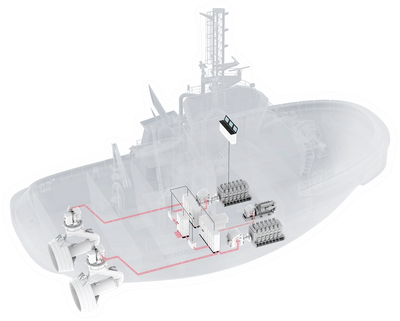Futureproof Tugs: Efficient, Sustainable and Automated
Tug owners are cutting emissions and increasing automation. Subject to technology choices, ‘greener’ tugs are a global phenomenon today, while the autonomous tugs of tomorrow are starting to emerge. David Lee S,enior Account Manager, New Build, ABB Marine & Ports, discusses tugs of the future.
Around the world, there is a growing appetite for hybrid and electric technology in tugboat operations. In the Asian and European towage markets, owners are responding to increasingly stringent regulations on air emissions in ports by investing in cleaner, more efficient propulsion. In the United States, too, the movement toward greener propulsion solutions is beginning to gather pace, partly driven by regulation but also by efforts from large corporations to reduce emissions using smarter solutions.
Energy efficiency tops the agenda
To assist vessels far larger than themselves, tugboats rely on the ability to generate a great deal of force, and in this regard, the conventional high-horsepower diesel engine serves them well. However, most of the time tugs operate far below their power capacity, with their engines therefore working at speeds well below optimum efficiency. At a time when vessel emissions have never been under closer scrutiny, tug owners have been at the frontline of those seeking smarter technologies that optimize efficiency whatever the engine load.
One result has been a growing preference for the types of hybrid and electric propulsion systems that use power more strategically, and can quickly align with a tugboat’s dynamic, unpredictable operations to achieve energy savings and reduced emissions. If a vessel is fitted with one of these systems during construction, it will also be far easier to upgrade as technology matures; in this sense, for its approximately 30-year lifespan, a tug specified with hybrid/electric propulsion today can be ‘futureproof’.
Finding the best fit
The motivation for going hybrid is clear. Yet with a variety of options available, tugboat operators need to make an informed decision. ABB Marine & Ports integrates everything from liquefied natural gas (LNG)/electric hybrid, battery hybrid and diesel electric to power take-off/power take-in (PTO/PTI), full battery and hydrogen fuel cells. Each option has its merits, and the vessel’s specific operating profile and preferences by technology users in different locations will determine which system is the best match.
For example, the combination of LNG as a marine fuel and electric motors handling dynamic loads delivers a highly efficient, low-emissions solution to the tugboat operator, but its suitability relies on the presence of fueling infrastructure in port. Full battery systems, meanwhile, can be among the most economical and environmentally friendly options but they can only be contemplated when necessary charging facilities are available.
With a wealth of experience in alternative propulsion technologies, ABB Marine & Ports aims to help tugboat owners to deploy their installed system in the most efficient way, no matter what their starting point.
A host of alternatives
An alternative propulsion technology of choice in the U.S., for example, is the PTO/PTI system, which strikes the balance between environmental and commercial drivers. This is an efficient hybrid technology in which the same unit can be used as a generator, booster motor or alternative power source. It entails only a partial shift from the conventional setup, which explains its popularity in a country that is still testing the waters on hybrid propulsion.
Sometimes, however, PTO/PTI systems are not sufficient for meeting emissions reduction targets because the operator’s profile is not the most suitable fit for them. It may be that the large main engine is still in use most of the time, and the power for the electric boost motors is supplied by smaller engines without advanced emission controls. This can in fact lead to increased carbon emissions.
Issues like this demand individual consideration, where ABB identified its role as that of a partner with operators as they seek smarter solutions, helping them to navigate the hybrid landscape and find the right option for their profile.
Electric. Digital. Connected.
The same partnering role is being played in the development of autonomous tugs, particularly in east- and southeast-Asian markets, where operators are seeking to assist crew and minimize the risk of human error.
To give an example, ABB, in collaboration with Keppel O&M’s technology arm, Keppel Marine and Deepwater Technology (KMDTech), is working on jointly developing the technology for autonomous vessels and retrofitting a 32-meter harbor tugboat with leading-edge digital solutions, enabling autonomous vessel operations in the Port of Singapore at the end of 2020. Upon project completion, the vessel is anticipated to be South Asia’s first autonomous tug.
Interest in the beneficial technologies that point towards the future operation of autonomous tugboats is greater than ever, as the need for safe, fuel-efficient towage operations becomes more urgent. The tugs of the future will be electric, digital and connected.

















